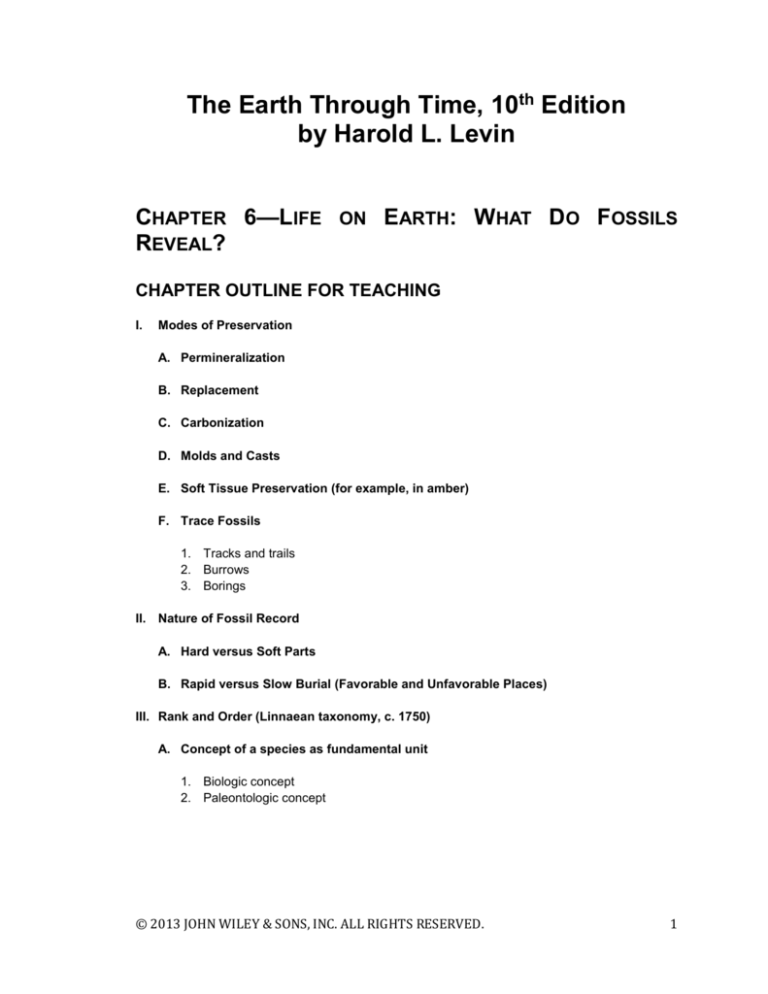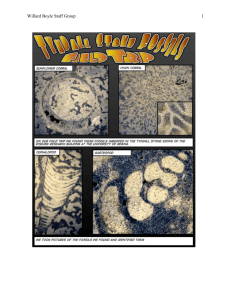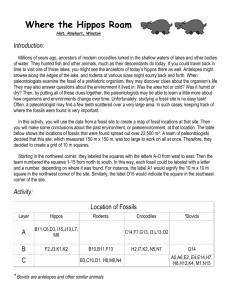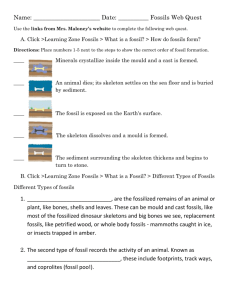
The Earth Through Time, 10th Edition
by Harold L. Levin
CHAPTER 6—LIFE ON EARTH: WHAT DO FOSSILS
REVEAL?
CHAPTER OUTLINE FOR TEACHING
I.
Modes of Preservation
A. Permineralization
B. Replacement
C. Carbonization
D. Molds and Casts
E. Soft Tissue Preservation (for example, in amber)
F. Trace Fossils
1. Tracks and trails
2. Burrows
3. Borings
II. Nature of Fossil Record
A. Hard versus Soft Parts
B. Rapid versus Slow Burial (Favorable and Unfavorable Places)
III. Rank and Order (Linnaean taxonomy, c. 1750)
A. Concept of a species as fundamental unit
1. Biologic concept
2. Paleontologic concept
© 2013 JOHN WILEY & SONS, INC. ALL RIGHTS RESERVED.
1
2
B. Taxonomic Order (Hierarchy)
1.
2.
3.
4.
5.
6.
7.
Kingdom
Phylum
Class
Order
Family
Genus
Species
C. Taxonomy of the Three Domains
1. Domain Archaea – methane-producing bacteria and bacteria capable of living in
extreme conditions
2. Domain Bacteria – cyanobacteria and many other prokaryotes
3. Domain Eukarya
a. Kingdom Protista (mostly single-celled organisms)
(1) heterotrophs – food devourers
(2) autotrophs – photosynthesizers
(3) saphrophytes – decomposers
b. Kingdom Fungi (multicellular eukaryotes, many of which are saprophytes)
c. Kingdom Plantae (autotrophic multicellular eukaryotes)
d. Kingdom Animalia (heterotrophic multicellular organisms)
IV. Organic Evolution
A. Lamarck’s Theory (c. 1815)
1. All species descended from others
2. New structures appear out of “need” or “want”
3. Once acquired, structures can be passed on
B. Darwin’s Mechanism of Natural Selection (1859)
1. Cause of variation was not known
2. Variations in a population are common
3. Favorable ariations in population allow survival
C. Mendelian Principles of Inheritance (1865)
1. Cause of variation was not known
2. Variation documented experimentally
D. Modern Genetics
1.
2.
3.
4.
Genes are determiners
DNA molecule active in hereditary transmission
Genes as part of DNA
Chromosomes as links within DNA
© 2013 JOHN WILEY & SONS, INC. ALL RIGHTS RESERVED.
2
3
E. Cell Division and Reproduction
1.
2.
3.
4.
5.
6.
Chromosomes kind and numbers are constant for a species
Diploid cells – cells with paired homologous chromosomes
Mitosis – regeneration of new cells in organisms
Meiosis – occurs in sexual reproduction when gametes are formed
Haploid cells – reproductive cells without paired chromosomes
Variation in offspring
a. mixing parental chromosomes
b. crossing over (exchange of severed segments during chromosome division)
F. Mutation as the Source of Variation
1. Mutation can occur spontaneously (without specific cause)
2. Mutation via UV-light, cosmic rays, gamma-rays, chemicals
3. Sex cell mutation strongly affects evolution
G. Modern Organic Evolution
1.
2.
3.
4.
5.
6.
7.
Change due to: mutation, natural selection
Concept of population
Concept of gene pool
Speciation is origin of species
Concept of reproductive or geographic barriers
Adaptive radiation
Gradual versus punctuated equilibrium
a. phyletic gradualism
b. punctuated equilibrium
8. Phylogeny and phylogenetic trees
a. phylogenetic tree
b. cladogram
9. Evidence of evolution
a. paleontologic
b. biologic (homologous structures, vestigial organs)
c. DNA sequences
V. Fossils and Stratigraphy: establishing age equivalence of strata using fossils
A. Key Findings
1.
2.
3.
4.
5.
Principle of fossil succession
Life has changed through time
Principle of superposition
Extinction: permanent loss of a species
Similar fossils in similar environments of same age
© 2013 JOHN WILEY & SONS, INC. ALL RIGHTS RESERVED.
3
4
B. Correlation by Fossils
1. Key fossils – correlative value based on geologic range
a. first occurrence (oldest)
b. last occurrence (youngest)
2. Assemblages of fossils – also have correlative value
3. Index (guide) fossils – abundant, widely dispersed, lived short time
4. Reworked fossils – fossils from a older interval
5. Biostratigraphic zones (biozones)
a. range zone
b. concurrent range zone
c. assemblage zone
VI. Ancient Environments and Fossils (Paleoecology)
A. Marine Realms
1. Pelagic (Neritic and Oceanic)
a. floaters (plankton and phytoplankton)
b. swimmers (nekton – such as crustaceans, cephalopods, and vertebrates)
2. Benthic: supratidal, littoral, sublittoral, bathyal, abyssal, hadal
a. bioturbation – animal-sediment interaction on seafloor
b. oozes – siliceous and calcareous bioclastic material on seafloor
c. carbonate compensation depth – depth at which carbonate dissolves on seafloor
(about 4-5 km)
B. Environmental Reconstruction (Paleogeography)
1. Land bridges, isolation, and migration
2. Species diversity and geography
3. Biofacies analysis
C. Ancient Climatic Reconstruction (Paleoclimatology)
1. Distribution of key plants and animals
2. Oxygen-16/Oxygen-18 isotopic ratios
VII. Overview of History of Life
A. Precambrian
1. First one billion years — no fossil record
2. More than 3.5 billion to 700 million years ago—bacteria, algae, cyannobacteria
(stromatolites)
3. 700 million years ago—fossil metazoans (worms, arthropods, and relatives of the
corals and jellyfish) first appear
© 2013 JOHN WILEY & SONS, INC. ALL RIGHTS RESERVED.
4
5
B. Phanerozoic
1. Evolution of plants
a. Late Ordovician – land plants appeared
b. Earliest Cretaceous – flowering plants appeared
2. Evolution of animals
a. Paleozoic: marine invertebrates, first vertebrates
b. Mesozoic: more marine invertebrates, land vertebrates
c. Cenozoic: more marine invertebrates and vertebrates; modern mammals
C. Mass Extinctions
1.
2.
3.
4.
5.
End of Ordovician
Late Devonian
End of Permian
Late Triassic
End of Cretaceous
VIII. Life on Other Planets
A. Life as We Know It: places to look
1. Mars
2. Jupiter’s satellites (Europa and Io)
3. Saturn’s satellite (Titan)
B. Life on other planets: there may be as many as 1000 or more planets in the
numerous other solar systems of the universe where there may be life as we define
it.
Answers to Discussion Questions
1. Factors in determining whether a fossil will be valuable and not as an indicator of age and for
correlation include: cosmopolitan distribution of the fossil, good preservation, and having a
relatively short span of existence.
2. a) Ordovician through Permian. b) Ordovician. c) Fossil A has the narrower age range, and
is therefore the better guide fossil.
3. The different, coeval fossil assemblages can be accounted for by different, coeval
environments and fossil assemblages of organisms sensitive to those environmental
differences.
4. These older fossils (conodonts) may have been reworked by erosion of a Devonian unit, thus
contributing fossil—containing detrital to the Permian unit.
© 2013 JOHN WILEY & SONS, INC. ALL RIGHTS RESERVED.
5
6
5. During Paleozoic, vascular land plants such as psilopsida, lycopsida (scale trees),
sphenopsida, pteropsida (tree ferns), pteridospermophyta (seed ferns), ginkophyta
(ginkgoes), and coniferophyta (conifers) existed on land. This list includes all main groups of
vascular land plants except angiosperms and cycads and cycadeoids.
6. a) Mitosis is the reproduction of exact copies of cells as in asexual reproduction and
production of somatic cells in sexually reproducing organisms. Meiosis is reproduction
unicellular or sexually reproducing multi-cellular organisms where in two divisions produce
four haploid (daughter) cells without paired chromosomes. The haploid cells are sexual
gametes which fuse during sexual reproduction. b) Cells without paired chromosomes are
haploid; cells with paired homologous chromosomes are diploid. c) Gymnosperms are nonflowering plants that produce pollen or seeds; angiosperms are flowering plants that produce
pollen or seeds. d) Cladograms like phylogentic trees show relationships between
organisms, but the cladogram is completely objective and ignores the age relationships
among organisms involved.
7. Adaptation is acquisition of heritable characteristics that are advantageous to an individual
and a population. The honey creepers of Hawaii, displaying various adaptations of beak
sizes and shapes, are a good example.
8. The theory of biologic evolution has been supported by the fossil succession record and
extinction evidence. The paleontologic evidence is at least as important to reconstruction of
past geographies as physical (sedimentologic evidence). The paleontologic evidence can be
a detailed record of past climate change as in isotopic shell studies and coiling patterns of
foraminifers, for example. Paleontologic evidence helps reconstruct ancient environments by
using fossils as clues (e.g., the mode of life of a trace or body fossil suggests characteristics
of ancient environments).
9. Darwin established natural selection as the driving force in macroevolution. Mendel
discovered the fact that unknown but heritable factors (genes) were the cause of the variation
Darwin observed.
10. The ranges of fossils are carefully documented in global correlation that has been studied for
many decades.
11. Phyletic gradualism and punctuated equilibrium are opposite in that the former stresses slow,
gradual change and the latter abrupt change, then stasis. A continuous core from the ocean
would intuitively yield better samples for study of gradual versus punctuated events.
12. The sublittoral zone is continuously covered by sea water, but is shallow enough for light to
penetrate readily to the seafloor. Light promotes the growth of algae and other marine plants,
which are important parts of the food chain. Soft, oxygenated bottom sediments are good
habitats for marine organisms that engage in bioturbation.
13. Heterotropic means that the organism has to consume something to make energy and it does
not make energy from the Sun. Prokaryotic means that the cell lacks a nucleus. And,
anerobic means that it does not require oxygen to survive.
14. e
15. b
© 2013 JOHN WILEY & SONS, INC. ALL RIGHTS RESERVED.
6
7
CHAPTER ACTIVITIES
Student activities for in-depth learning:
1. There are many different types of trace fossils and these are made by various organisms
interacting with the sediment during the time they lived. Take a look at the various types of trace
fossils and make a list of all of them by looking that the Nova Scotia Museum page at
http://museum.gov.ns.ca/mnh/nature/tracefossils/english/. Visit the “Whodunnit” section of this
page and make a sketch of three different trace fossils and explain how the organism in question
made each trace fossil.
2. Using your computer’s search engine, conduct a search for “stromatolites.” Take a look at
images of both modern and ancient stromatolites. How and where do stromatolites form today
and how and where did they form in the distant past? Just how far back in the geological record
do we find stromatolites? Based on the field photographs you find on the web showing
stromatolites, how would you recognize one yourself? Why do you suppose stromatolites have
been alive so long on Earth? Use web resources and your textbook for answers.
© 2013 JOHN WILEY & SONS, INC. ALL RIGHTS RESERVED.
7








